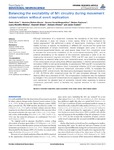Mostrar el registro sencillo del ítem
Balancing the excitability of M1 circuitry during movement observation without overt replication
| dc.contributor.author | Arias, Pablo | |
| dc.contributor.author | Robles-García, Verónica | |
| dc.contributor.author | Corral Bergantiños, Yoanna | |
| dc.contributor.author | Espinosa, Nelson | |
| dc.contributor.author | Mordillo-Mateos, Laura | |
| dc.contributor.author | Grieve, Kenneth | |
| dc.contributor.author | Oliviero, Antonio | |
| dc.contributor.author | Cudeiro, Javier | |
| dc.date.accessioned | 2015-04-23T11:55:04Z | |
| dc.date.available | 2015-04-23T11:55:04Z | |
| dc.date.issued | 2014-09-17 | |
| dc.identifier.citation | Arias P, Robles-García V, Corral-Bergantiños Y, Espìnosa N, Mordillo-Mateos L, Grieve K, Oliviero A, Cudeiro J. Balancing the excitability of M1 circuitry during movement observation without overt replication. Front Behav Neurosci. 2014;8:316 | es_ES |
| dc.identifier.uri | http://hdl.handle.net/2183/14447 | |
| dc.description.abstract | [Abstract] Although observation of a movement increases the excitability of the motor system of the observer, it does not induce a motor replica. What is the mechanism for replica suppression? We performed a series of experiments, involving a total of 66 healthy humans, to explore the excitability of different M1 circuits and the spinal cord during observation of simple movements. Several strategies were used. In the first and second experimental blocks, we used several delay times from movement onset to evaluate the time-course modulation of the cortico-spinal excitability (CSE), and its potential dependency on the duration of the movement observed; in order to do this single pulse transcranial magnetic stimulation (TMS) over M1 was used. In subsequent experiments, at selected delay times from movement-onset, we probed the excitability of the cortico-spinal circuits using three different approaches: (i) electric cervicomedullary stimulation (CMS), to test spinal excitability, (ii) paired-pulse TMS over M1, to evaluate the cortical inhibitory-excitatory balance (short intracortical inhibition (SICI) and intracortical facilitation (ICF)], and (iii) continuous theta-burst stimulation (cTBS), to modulate the excitability of M1 cortical circuits. We observed a stereotyped response in the modulation of CSE. At 500 ms after movement-onset the ICF was increased; although the most clear-cut effect was a decrease of CSE. The compensatory mechanism was not explained by changes in SICI, but by M1-intracortical circuits targeted by cTBS. Meanwhile, the spinal cord maintained the elevated level of excitability induced when expecting to observe movements, potentially useful to facilitate any required response to the movement observed. | es_ES |
| dc.description.sponsorship | Work was supported by Xunta de Galicia (Conselleria de Educación-2007/000140-0 and Dirección Xeral de I+D+i; 2010-2012), Spain. Verónica Robles-García and Yoanna Corral-Bergantiños are granted by the FPU-MECD AP2010-2774 and AP2010-2775 Spain. | |
| dc.description.sponsorship | Xunta de Galicia; 2007/000140-0 | |
| dc.description.sponsorship | info:eu-repo/grantAgreement/MECD/Programa Nacional de Formación/AP2010-2774/ES | |
| dc.description.sponsorship | info:eu-repo/grantAgreement/MECD/Programa Estatal de Promoción del Talento y su Empleabilidad/AP2010-2775/ES | |
| dc.language.iso | eng | es_ES |
| dc.publisher | Frontiers | es_ES |
| dc.relation.uri | http://dx.doi.org/10.3389/fnbeh.2014.00316 | es_ES |
| dc.rights | Creative Commons Attribution 4.0 International License (CC-BY 4.0) | es_ES |
| dc.rights.uri | http://creativecommons.org/licenses/by/4.0/ | |
| dc.subject | Movement observation | es_ES |
| dc.subject | Replica cancelation | es_ES |
| dc.subject | Motor cortex | es_ES |
| dc.subject | Human | es_ES |
| dc.subject | Mirror Neuron system | es_ES |
| dc.title | Balancing the excitability of M1 circuitry during movement observation without overt replication | es_ES |
| dc.type | journal article | es_ES |
| dc.rights.accessRights | open access | es_ES |
| UDC.coleccion | Investigación | es_ES |
| UDC.departamento | Fisioterapia, Medicina e Ciencias Biomédicas | es_ES |
| UDC.grupoInv | Neurociencia e Control Motor (NEUROcom) | es_ES |
| UDC.grupoInv | Neurociencia e Control Motor (INIBIC) | es_ES |
| UDC.institutoCentro | INIBIC - Instituto de Investigacións Biomédicas de A Coruña | es_ES |
Ficheros en el ítem
Este ítem aparece en la(s) siguiente(s) colección(ones)
-
Investigación (FCS) [1295]






